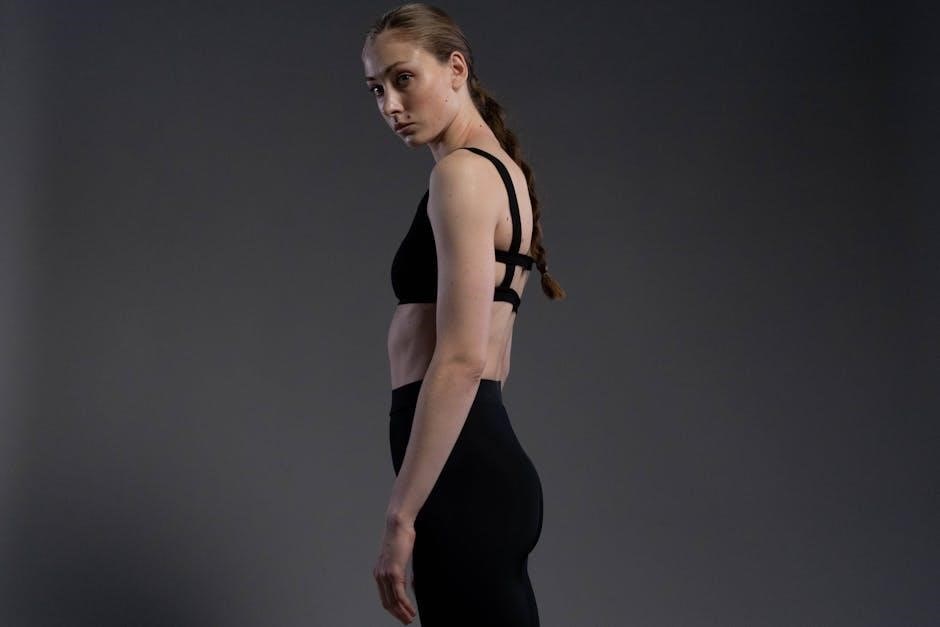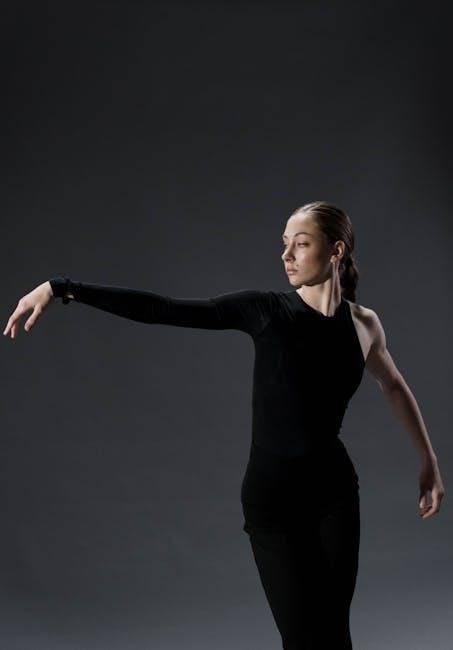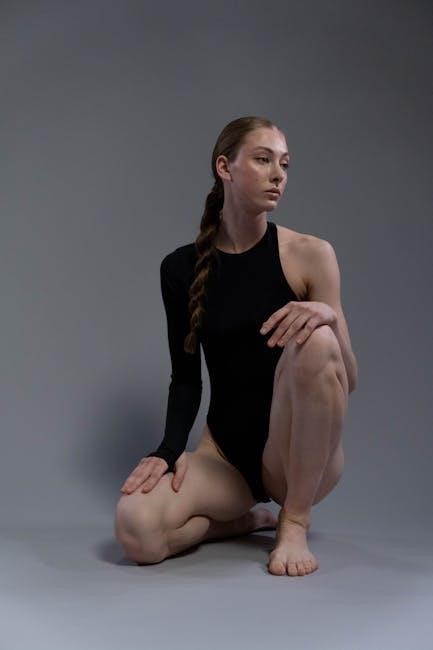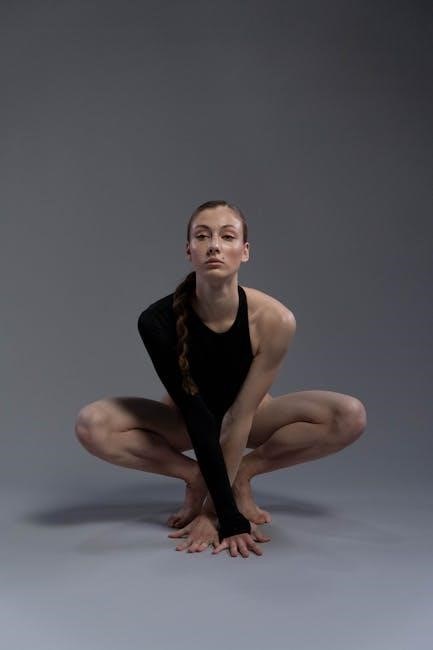Hatha Yoga is a traditional practice combining physical postures, breathing techniques, and relaxation to balance body, mind, and energy. A 60-minute sequence offers a comprehensive guide for practitioners, promoting flexibility, strength, and mindfulness while fostering overall well-being through structured flows and breathing exercises.
What is Hatha Yoga?

Hatha Yoga is a traditional and holistic practice combining physical postures (asanas), breathing techniques (pranayama), and relaxation to balance the body’s energy. It focuses on preparing the physical body for meditation by harmonizing opposites (e.g., sun and moon energies). This ancient practice emphasizes alignment, breath awareness, and inner calm, making it accessible to all levels. A 60-minute sequence provides a structured approach to explore these elements, promoting wellness and mindfulness through a balanced flow of movements and breathwork.
Benefits of a 60-Minute Hatha Yoga Practice
A 60-minute Hatha Yoga practice offers numerous benefits, including improved flexibility, strength, and balance. It reduces stress, enhances mindfulness, and promotes deep relaxation. Regular practice boosts circulation, improves posture, and enhances respiratory function. The structured sequence also helps prepare the body for meditation, fostering emotional calm and mental clarity. This holistic approach supports overall wellness, making it ideal for both beginners and experienced practitioners seeking physical and mental rejuvenation through a balanced and therapeutic practice.

Structure of a 60-Minute Hatha Yoga Sequence
A 60-minute Hatha Yoga sequence typically includes warm-up (5 min), standing poses (15 min), seated poses and twists (15 min), backbends and forward folds (10 min), and relaxation (5 min), ensuring a balanced practice.
Warm-Up and Preparation (5 Minutes)
The warm-up begins with a comfortable seated position, focusing on deep breathing to center the mind. Gentle neck rolls, shoulder shrugs, and wrist and ankle rotations follow to loosen joints. A brief cat-cow stretch warms the spine, while leg swings and arm circles prepare the body for movement. This initial phase ensures a smooth transition into the practice, optimizing flexibility and preventing injury. It sets the tone for a balanced and mindful 60-minute Hatha Yoga sequence.
Standing Poses and Sun Salutations (15 Minutes)
Begin with Mountain Pose (Tadasana) for alignment and grounding. Transition into Sun Salutations (Surya Namaskar) to warm up the body, flowing through Forward Fold, Plank, and Downward-Facing Dog. Incorporate standing poses like Warrior I (Virabhadrasana I) and Triangle Pose (Trikonasana) to build strength and flexibility. Each movement is synchronized with breath, promoting fluidity and mindfulness. This dynamic sequence enhances cardiovascular health and prepares the body for deeper postures, fostering balance and energy flow. It sets a strong foundation for the practice ahead. Proper alignment is emphasized throughout to ensure safety and effectiveness.
Seated Poses and Twists (15 Minutes)
Transition to seated poses to deepen the practice and enhance flexibility. Begin with Seated Forward Bend (Paschimottanasana) to stretch the hamstrings and spine. Incorporate Seated Spinal Twist (Bharadvajasana) to improve posture and detoxify the body. Use props like blocks or straps for support if needed. These poses promote relaxation, balance, and inner awareness. Twists aid in cleansing the nervous system, while seated postures prepare the body for deeper stretches and meditative states, fostering overall well-being and mental clarity. Proper alignment ensures safe and effective practice. This segment is designed to calm the mind and rejuvenate the body, laying a strong foundation for the next phase of the sequence. By focusing on breath and movement, practitioners can achieve a harmonious balance between physical and mental relaxation, making this section a cornerstone of the 60-minute Hatha Yoga practice. The careful selection of seated poses and twists ensures that each movement is purposeful and beneficial, contributing to a holistic yoga experience.
Backbends and Forward Folds (10 Minutes)
Begin with gentle backbends like Cobra Pose (Bhujangasana) to strengthen the spine and open the chest, followed by Cat-Cow (Marjaryasana-Bitilasana) for spinal mobility. Transition into Standing Forward Fold (Uttanasana) to release the hamstrings and shoulders. Use blocks for support if needed. These poses enhance flexibility, improve posture, and prepare the body for deeper stretches. Forward folds promote relaxation, while backbends energize the body. This segment balances strength and surrender, fostering a harmonious flow of energy and preparing for the final relaxation phase. Proper breathing and alignment are key to maximizing benefits and ensuring a safe practice. The combination of backbends and forward folds creates a dynamic yet meditative sequence, essential for a well-rounded Hatha Yoga practice.
Relaxation and Final Savasana (5 Minutes)
Conclude the practice with deep relaxation techniques, transitioning into Savasana (Corpse Pose). Guide students to lie comfortably on their backs, arms and legs relaxed. Use calming cues to quiet the mind and release tension. Dimmed lighting or soothing music can enhance the experience. This segment allows the body to absorb the benefits of the practice, reducing stress and promoting inner peace. End with gentle reminders to slowly return to awareness, leaving students refreshed and centered. Proper relaxation is key to a complete Hatha Yoga experience. It rejuvenates the mind, body, and spirit, ensuring a sense of balance and calm.

Key Asanas in a 60-Minute Hatha Yoga Sequence

A 60-minute Hatha Yoga sequence includes foundational poses like Mountain Pose (Tadasana), Cobra Pose (Bhujangasana), Downward-Facing Dog (Adho Mukha Svanasana), and Seated Forward Bend (Paschimottanasana), promoting strength, flexibility, and alignment. These poses form the core of a balanced practice, fostering physical stability and mental focus, while preparing the body for deeper relaxation and breath awareness. Proper alignment and breathing are emphasized to maximize benefits and prevent injury, ensuring a holistic yoga experience.
Mountain Pose (Tadasana)
Tadasana, or Mountain Pose, is a foundational standing posture that establishes proper alignment and balance. It involves standing tall with feet hip-width apart, arms by the sides, and palms facing forward. Engage the core, lengthen the spine, and feel a sense of grounding. This pose improves posture, promotes stability, and prepares the body for other asanas. It also enhances body awareness and reduces back pain by strengthening spinal muscles. Regular practice fosters confidence and a strong, centered presence.
Cobra Pose (Bhujangasana)
Cobra Pose, or Bhujangasana, is a gentle backbend that strengthens the upper and middle back muscles while opening the chest. Lie on your stomach with hands under your shoulders. Inhale and press your palms into the ground, lifting your chest and head off the mat. Keep your shoulders down and neck relaxed. This pose improves posture, reduces back pain, and enhances breathing capacity. It also energizes the body and boosts confidence. Modify by lifting slightly or using a block for support if needed.
Downward-Facing Dog (Adho Mukha Svanasana)
Adho Mukha Svanasana, or Downward-Facing Dog, is a foundational standing pose that stretches the hamstrings, calves, and spine while strengthening the arms and shoulders. Begin on all fours, then lift your hips, straightening your arms and legs, forming an inverted V. Keep your head in a neutral position and engage your core. This pose improves flexibility, balance, and circulation. It also prepares the body for deeper stretches and inversions. Modify by bending your knees or using blocks for support if needed.
Seated Forward Bend (Paschimottanasana)
Paschimottanasana, or Seated Forward Bend, is a deep stretch for the hamstrings, spine, and entire back side of the body. Sit with extended legs, feet flexed, and spine straight. Inhale, lengthen, then exhale, folding forward from the hips, reaching toward your toes. Use a strap or modify by bending knees if needed. This pose enhances flexibility, relieves tension, and calms the nervous system. It is often practiced after standing poses to deepen the stretch and prepare for backbends or twists in a 60-minute Hatha Yoga sequence.

Breathing Techniques in Hatha Yoga
Hatha Yoga emphasizes various breathing techniques to promote relaxation, focus, and energy balance. Methods like Ujjayi and Nadi Shodhana are integral, enhancing the flow of a 60-minute sequence.
Ujjayi (Ocean Breath)
Ujjayi, or Ocean Breath, is a key technique in Hatha Yoga, involving a soft hissing sound produced by narrowing the throat. This breath is calming, regulates the nervous system, and enhances focus during asanas. It is particularly effective during a 60-minute sequence, promoting a meditative state and balancing energy. Ujjayi is often used throughout the practice to maintain a steady rhythm and deepen the connection between movement and breath, fostering mindfulness and relaxation.
Bhramari (Bee Breath)
Bhramari, or Bee Breath, is a soothing breathing technique in Hatha Yoga that mimics the sound of a buzzing bee. Practiced by inhaling and exhaling through the nose with the mouth closed, it creates a calming vibration in the throat. This breath helps reduce stress, calm the mind, and prepare the body for meditation. Often used during relaxation phases of a 60-minute sequence, Bhramari promotes inner peace and mental clarity, enhancing the overall meditative experience of the practice.
Nadi Shodhana (Alternate Nostril Breathing)
Nadi Shodhana, or Alternate Nostril Breathing, is a powerful Hatha Yoga technique that balances the body’s energy. By alternately closing each nostril with the thumb and pinky finger, this practice harmonizes the breath, calming the nervous system. It prepares the mind for meditation, reduces stress, and improves respiratory efficiency. Often included in a 60-minute sequence, Nadi Shodhana enhances focus and promotes a sense of inner balance, making it a key component of a holistic yoga practice.

Modifications for Beginners
Hatha Yoga modifications for beginners emphasize listening to the body, using props like blocks and blankets, and practicing at one’s own pace. Rest when needed.
Using Props for Support
Using props like blocks, blankets, and straps is essential for modifying poses in a 60-minute Hatha Yoga sequence. Blocks provide height for standing poses, blankets support seated postures, and straps aid in stretching. These tools ensure proper alignment, prevent strain, and make poses accessible for all levels. Beginners can use props to enhance their practice, fostering safety and comfort. They allow for gradual progression, making the sequence enjoyable and effective without risking injury.
Adjusting Poses for Different Fitness Levels
Adjusting poses ensures a safe and effective practice for all participants. Beginners can modify postures using props or gentle alternatives, while advanced practitioners can deepen stretches or hold poses longer. Offering variations for each pose accommodates different fitness levels, ensuring accessibility and engagement. This approach fosters inclusivity, allowing everyone to benefit from the sequence without strain or discomfort. Proper adjustments enhance the practice, making it suitable for a diverse range of abilities and promoting a balanced, enjoyable experience for all.
Final Tips for a Successful Practice
For a successful 60-minute Hatha Yoga practice, start with a proper warm-up to prevent injuries and enhance flexibility. Focus on breath awareness, synchronizing movements with inhalations and exhalations. Use props like blocks or straps to modify poses as needed, ensuring comfort and alignment. Maintain a steady pace, allowing time to transition smoothly between asanas. End with a relaxing Savasana to recharge and reflect, fostering mindfulness and inner calm. Consistency is key to experiencing the full benefits of this practice.
Importance of Consistency in Yoga
Consistency is vital for maximizing the benefits of a 60-minute Hatha Yoga practice. Regular sessions enhance physical flexibility, mental focus, and emotional balance. Over time, consistent practice strengthens muscles, improves posture, and boosts circulation. It also deepens breathing techniques, leading to better stress management and overall well-being. Incorporating Hatha Yoga into your daily routine fosters discipline and mindfulness, creating a lasting positive impact on both body and mind. A steady practice ensures progress and sustained holistic health.